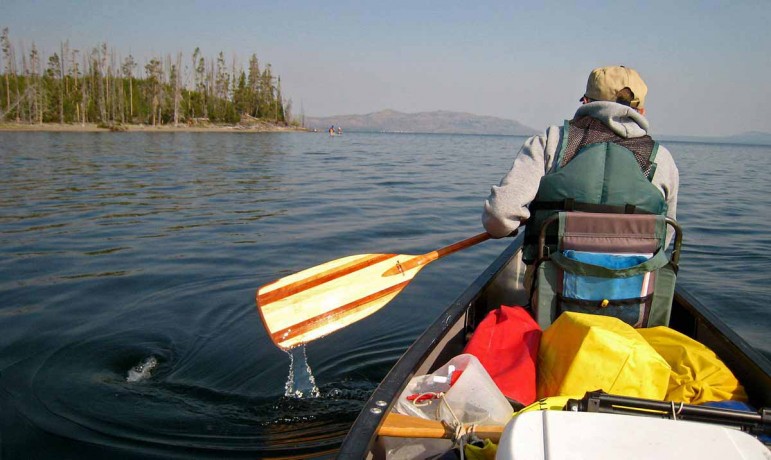
The head of the National Park Service is “strongly opposed” to proposed legislation that would open rivers in Yellowstone and Grand Teton national parks to paddlers, saying the bill caters to “the benefit of a very select few.”
In a Nov. 13 letter to Rep. Bob Bishop (R-Utah), chair of the House Natural Resources Committee, Park Service Director Jonathan B. Jarvis said the bill would hamper his agency’s ability to properly manage Yellowstone’s rivers and other natural resources.
Introduced by Rep. Cynthia Lummis (R-Wyo.), H.R. 974 would require the Park Service to establish rules for the use of kayaks, canoes, rafts and other “hand-propelled” watercraft on 50 specific river segments in Yellowstone National Park and parts of Grand Teton National Park that are not currently open to paddling.
The bill was approved last month by the House committee, but its fate is uncertain. It could be ignored during a busy year-end session of Congress, or included as a rider in a wide-ranging federal spending bill.
While many national parks allow recreational paddlers, Yellowstone restricts such use to lakes, banning all paddlers from the park’s rivers and streams. In Grand Teton, paddling is allowed on some lakes and a 26-mile segment of the Snake River.
Jarvis said in his letter that Yellowstone’s rivers are unlike any other scenic resource in the country, and are home to sensitive and endangered fish and birds. Opening rivers to paddlers would also increase the risk of transmitting aquatic invasive species, he said.
If the bill is passed, “the interests of a small group of recreational paddlers would be placed above those of all other Americans and above the protection of these fragile resources,” Jarvis wrote.
Yellowstone already allows paddling on almost all of the park’s lakes, and issues 2,000 permits annually for non-motorized boating, Jarvis wrote.
Park advocates have criticized the bill for how it forces the Park Service to address the issue of paddling in Yellowstone, saying it sets a bad precedent and amounts to Congressional meddling in how park resources are managed.
Stephanie Adams, Yellowstone program manager for the National Parks Conservation Association, said opening Yellowstone’s rivers to paddlers could “damage native trout habitat and serve to disrupt prime habitat for endangered grizzly bears.”
Backers of the bill say Yellowstone managers have repeatedly declined to engage them on the matter, citing a 1950 paddling ban as prohibiting them from considering allowing paddling, or even studying the issue.
Lummis said the paddling ban is “no longer applicable” and amounts to “outdated regulations (that) have prevented responsible public enjoyment of these waterways.”
“I took great care to ensure the Park Service has the time, resources, and public input necessary to write a responsible management plan,” Lummis said in a written statement.
Under the proposed law, the Park Service would retain management over paddling and set rules based on environmental reviews. Commercial rafting would not be allowed on any newly opened rivers or streams.
Lummis said the bill would “align Yellowstone and Grand Teton National Park with other national parks across the country that offer this low-impact way for the public, and especially America’s youth, to have truly unforgettable experiences.”
Excluded from the list of rivers proposed for paddling are most of the Teton high country, Hayden Valley, Lamar Valley, Firehole River through the geyser basins and Gibbon River, according to the American Packrafting Association, which has lobbied Lummis on the legislation.
Brad Meiklejohn, Packrafting Association president, said that anglers, hikers and equestrians already frequent many of the rivers paddlers want to use, and that Jarvis has “has prematurely and inappropriately drawn conclusions” about paddling “without his agency ever having done a thorough analysis.”
Contact Ruffin Prevost at 307-213-9818 or [email protected].

Tend to agree with Mr. Jarvis of the National Park Service on this issue. Congress has repeatedly cut funding from the parks while trying to force them to do more things that require funding and additional manpower. Much of the Yellowstone ecosystem is already under considerable stress from tourists and outdoor types who frequent the backcountry. Incidents involving tourists and animals or habitat have been inceasing over the years. How many bison and bear issues do we already have, and how much would opening more waterways to boaters increase the number? Hell, we even have idiots flying drones into pristine geyser basins and crashing them there.
Congresswomen Loomis is just trying to facilitate ease of access to a very select group of individuals that already has incredibly good alternatives in the region. Paddlers have access to countless streams and lakes between Jackson Hole and Bozeman to the north and south, and between Idaho Falls and Cody to the east and west. There is no sensible reason to force the National Park Service to open more streams to this group. People like Loomis have no comprehension whatsoever of how difficulty policing these proposed areas would be for existing staff in the two parks, or what the cost burden might be.
What happens when you have the inevitable accidents in these newly opened areas, and some paddlers die in these incidents? Rest assured that Congresswomen Loomis would be the first one to point her finger at the National Park Service for not being proactive in protecting these paddlers. Just say NO to this overreach by yet another special interest group. They are not harmed or infringed upon in any way by not opening additional waterways in these two parks.